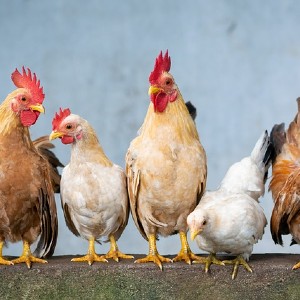The detection of fowl adenovirus in chickens with hydropericardium syndrome in Isfahan and Charmahal-Va-Bakhtiyari provinces, Iran

Accepted: November 18, 2022
All claims expressed in this article are solely those of the authors and do not necessarily represent those of their affiliated organizations, or those of the publisher, the editors and the reviewers. Any product that may be evaluated in this article or claim that may be made by its manufacturer is not guaranteed or endorsed by the publisher.
The hydropericardium in chickens is most common in Isfahan and Chcharmahal-va-Bakhtiyari, Iran. For this, the study was achieved for investigation of adenovirus role in induction of hydropericardium in these regions. In this study, 20 broiler flocks suspected to hydropericardium were sampled from hydropericardium fluid. Then, DNA was extracted and amplified by specific primers. The amplified fragment for detection of AV was 896 bp. The results showed that 10 in 20 flocks, and 47 in 200 samples were positive to AV. The results revealed that most of infected flocks were more than 30 days old. In this study, the correlation between infectivity to adenovirus and husbandry system were not significant. The infectivity rate in Isfahan and Chaharmahal-va-Bakhtiyari was not significant. Therefore, in addition to high altitude, adenovirus infection can play a role in increasing the prevalence of hydropericardium in these areas.
Mihail D, Jindal N, Tiwari AK, et al. Characterization of fowl adenoviruses associated with hydropericadium syndrome and IBH in broiler chickens. Virus Dis 2014; 25: 114-9. DOI: https://doi.org/10.1007/s13337-013-0183-7
Harrach B, Tarján ZL, Benkő M. Adenoviruses across the animal kingdom: a walk in the zoo. FEBS letters. 2019; 593(24): 3660-73. DOI: https://doi.org/10.1002/1873-3468.13687
Zhang T, Jin Q, Ding P, et al. Molecular epidemiology of hydropericardium syndrome outbreak associated serotype 4 fowl adenovirus isolates in central China. Virol J 2016; 13: 188-200. DOI: https://doi.org/10.1186/s12985-016-0644-x
Gholami-Ahangaran M, Fathi-Hafshejani E, Seyed-Hosseini R. Seromolecular study of chicken infectious anemia in chickens, ostriches, and turkeys in Iran. J Appl Poult Res 2013; 22(3): 404-9. DOI: https://doi.org/10.3382/japr.2012-00567
Chandra R, Shukla SK, Kumar M. The hydropericardium syndrome and inclusion body hepatitis in domestic fowl. Trop Anim Health Prod 2000; 32: 99-111. DOI: https://doi.org/10.1023/A:1005230703093
Ghocca S, Kurzbauen R, Cotton M. The complete DNA sequence and genomic organization of avian adenovirus CELLO. J Virol 1996; 70: 2939-49. DOI: https://doi.org/10.1128/jvi.70.5.2939-2949.1996
Natghi E, Razmyar J, Bassami R. Molecular characterization of avian adenovirus in Iranian broiler flocks. Iran J Vet Res 2014; 15:164-7.
Ghafari PT, Broomand Z, Rezaie A, et al. Detection and identification of avian adenovirus in broiler chickens suspected of IBH in Khuzestan, Iran, during 2015-2016. Iran J Vet Sci Technol 2017; 2:41-5.
Gholami-Ahangaran M, Fathi-Hafshejani E, Kamali H. Incidence of ascites in broilers affected by respiratory syndrome in Isfahan and Chaharmahal-va-Bakhtiyari provinces. Iran Vet Clinical Pathol 2015; 9: 91-101.
Herdt P, Timmerman T, Defoort P, et al. Fowl adenovirus infection in Belgian broiler: a ten years' survey. Vlaams Diergeneeskd. Tijdschr 2013; 82:125-32. DOI: https://doi.org/10.21825/vdt.v82i3.16704
Hosseini H, Morshed R. Molecular identification of fowl adenovirus associated with IBH in Iran in Iran. Iran J Virol 2012; 6: 7-12. DOI: https://doi.org/10.21859/isv.6.4.7
Shah MS, Ashraf A, Khan MI. Fowl adenovirus: history, emergence, biology and development of a vaccine against hydropericardium syndrome. Arch Virol 2017; 162: 1833-43. DOI: https://doi.org/10.1007/s00705-017-3313-5
Du D, Zhang P, Li X. Cell-culture derived fowl adenovirus serotype 4 inactivated vaccine provides complete protection for virus infection on SPF chickens. Virus Dis 2017; 28: 182-8. DOI: https://doi.org/10.1007/s13337-017-0372-x
Kim MS, Lim TH, Lee DH. An inactivated oil-emulsion fowl Adenovirus serotype 4 vaccine provides broad cross-protection against various serotypes of fowl Adenovirus. Vaccine 2014; 32: 3564-8. DOI: https://doi.org/10.1016/j.vaccine.2014.03.015
Copyright (c) 2023 the Author(s)

This work is licensed under a Creative Commons Attribution-NonCommercial 4.0 International License.
PAGEPress has chosen to apply the Creative Commons Attribution NonCommercial 4.0 International License (CC BY-NC 4.0) to all manuscripts to be published.


 https://doi.org/10.4081/jbr.2023.10353
https://doi.org/10.4081/jbr.2023.10353



